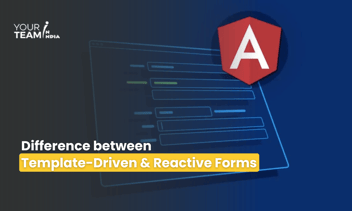Quick Summary: Dive into the world of React forms with our comprehensive guide, demystifying the process of creating dynamic and interactive forms. Explore best practices, state management, and form validation techniques to empower your React applications with seamless user input and enhanced functionality.
Introduction
Forms are used in React to gather and organize user input. They let users enter data, choose options, and submit information to interact with a web application. Form elements are managed by the state of a React component using the controlled component approach offered by React.
There are two types of forms in React: Controlled components and Uncontrolled components.
Controlled Components
React's state manages the form data in a controlled component. React controls the input fields, which implies that the React component that renders the form also controls the form's behavior in response to user input in the future.
1.1. State Management: To store the form data, define state variables. As the user works with the form, update the state.
1.2. Form Submission: Use the form's ‘onSubmit’ event to manage form submission.
Uncontrolled Components
The DOM manages the form data in an uncontrolled component. The form elements' state is independent of React. Alternatively, you can work directly with the DOM by utilizing React Refs.
2.1. Usage of References: To access the current values, create references for form elements.
2.2. Form Submission: Use the form's 'onSubmit' event to handle the form submission.
Difference Between Controlled and Uncontrolled Components
|
S.No. |
Feature |
Controlled Components |
Uncontrolled Components |
| 1. |
State Management |
The React component state manages the state. |
React does not manage the state; it uses refs to access DOM. |
| 2. |
Data Flow |
Data flow is predictable and controlled by React. |
Data flow is less predictable as it relies on the DOM. |
| 3. |
State Updates |
Updates to the state trigger re-renders of the component. |
No re-renders occur automatically on state updates. |
| 4. |
Form Elements Value |
The React state controls values of form elements. |
Values are obtained directly from the DOM using refs. |
| 5. |
Validation and Formatting |
Easier to implement validation and formatting. |
Validation and formatting may be more manual. |
| 6. |
Testing |
Easier to test as the state is controlled and predictable. |
Testing may be a bit more complex due to DOM reliance. |
| 7. |
Performance |
React has more control over optimizations. |
It may have better performance in certain scenarios. |
| 8. |
Code Complexity |
Generally, more code due to state management. |
There is less code for simple forms, but it may get complex for complex forms. |
| 9. |
Synchronization with External Events |
React handles synchronization with external events. |
Direct manipulation is required for synchronization. |
| 10. |
Use Cases |
Ideal for complex forms with dynamic behavior. |
Suitable for simpler forms where control is not critical. |
Advantages
Forms are a useful and efficient way to handle user input in React because of their many benefits. The following are some of the main benefits:
- Declarative Syntax: React offers a declarative syntax for form definitions, which facilitates code comprehension and maintenance. Declarative code describes the control flow of a computation but does not describe its logic.
- Component-Based Structure: Form logic can be contained within reusable components thanks to React's component-based architecture. This facilitates form management and upkeep, particularly in large applications with intricate user interfaces.
- State Management: You can effectively track form data and user input with React's state management feature. You can quickly update and synchronize the user interface (UI) with the current state by storing form values in the state.
- Reusable Components: React allows form elements to be contained within reusable components. This encourages the reuse of code and makes it simple to keep the appearance and functionality of various application components consistent.
- Validation and Error Handling: Form validation and error handling can be easily implemented with React. You are able to confirm.
Disadvantages
Although there are numerous benefits to using forms in React, there are a few possible drawbacks as well:
- Complexity for Simple Forms: For very simple forms, React's controlled components and state management may be too much, adding needless complexity.
- Learning Curve: The comprehension of React's controlled components, state management, and form handling may prove to be challenging for novices.
- Boilerplate Code: When handling user input through controlled components and managing form state, particularly with larger and more intricate forms, some boilerplate code may be produced.
- Performance Issues: Under some circumstances, the automatic re-rendering of React components upon each state change may give rise to performance issues, particularly if not effectively handled.
- Direct DOM Manipulation for Uncontrolled Components: Using refs to manipulate the DOM directly for uncontrolled components may be necessary. This goes against the standard React data flow paradigm and may result in less predictable behaviour.
Conclusion
React forms provide a strong and adaptable method for managing user input. React offers a declarative, component-based architecture that facilitates reusability, seamless integration of validation, and effective state management. Even though there might be some complications, particularly for more basic forms, the benefits—like maintainability and code organization—usually exceed the drawbacks.
The particular requirements of the application determine which components should be controlled or uncontrolled. All things considered, React's form-building methodology improves the creation of dynamic and engaging user interfaces.
Looking for the best talent to bring your web projects to life? Hire ReactJs developers to turn your vision into reality. Don't miss out on the opportunity to work with the top professionals in the field. Let's build something amazing together!








